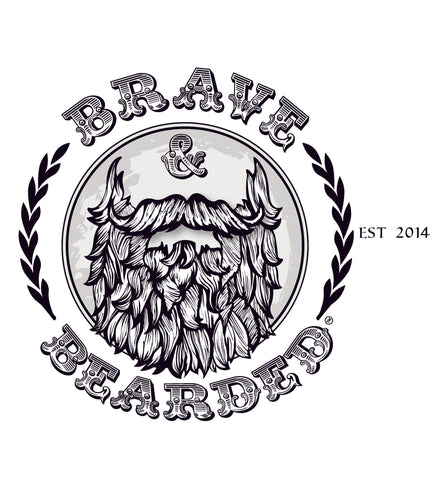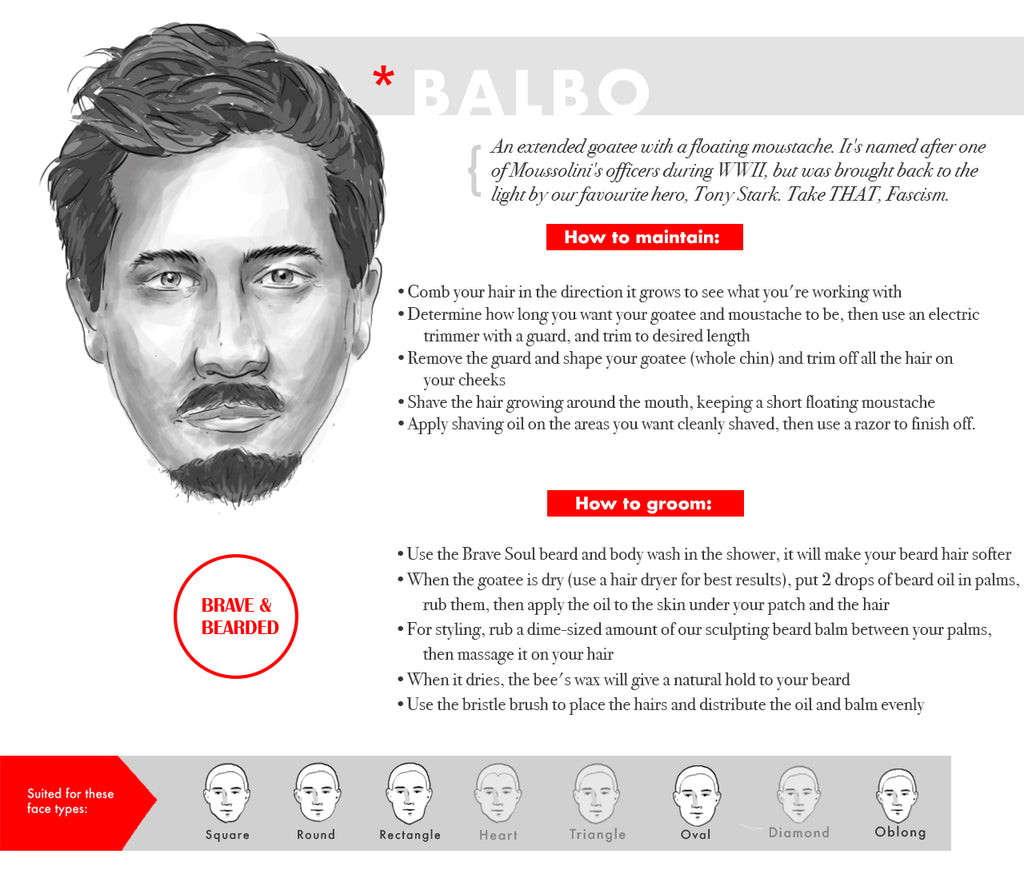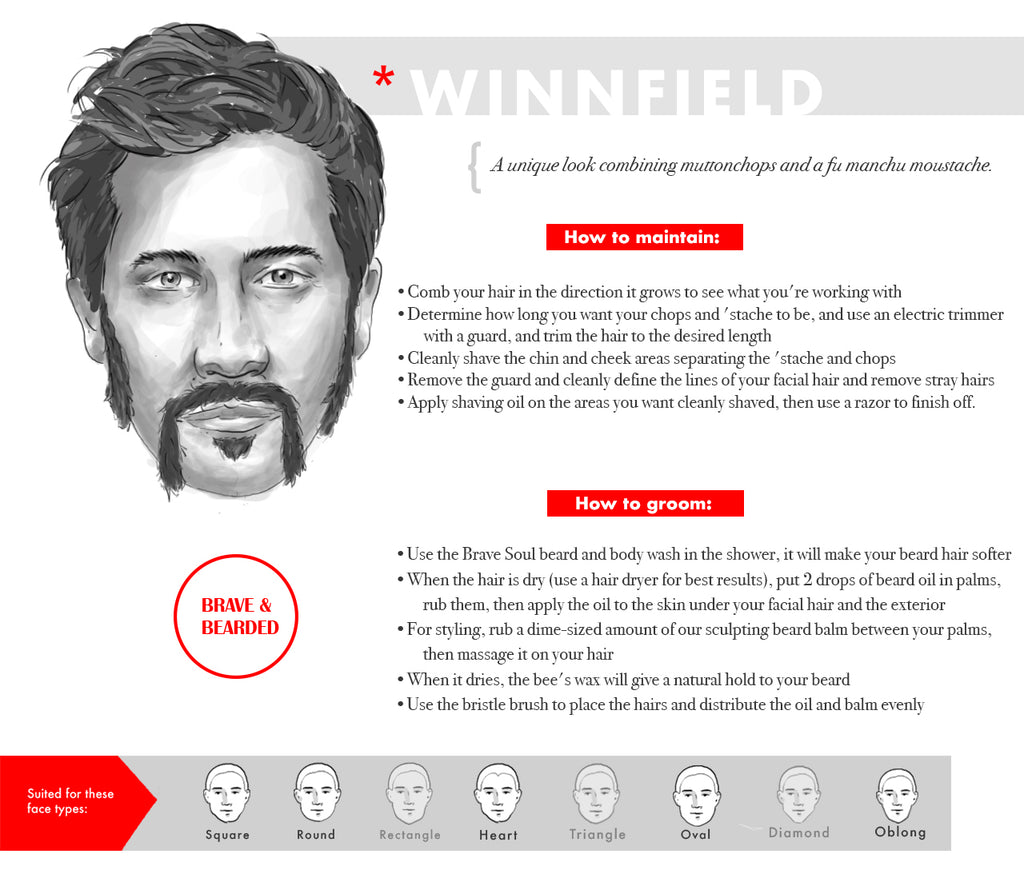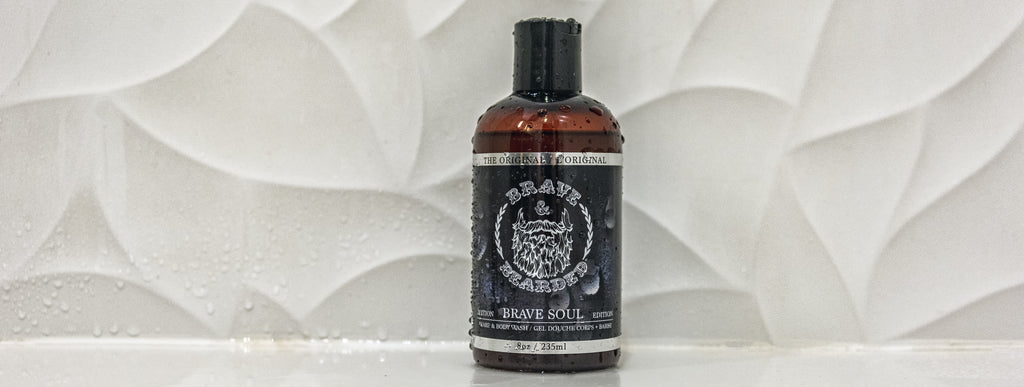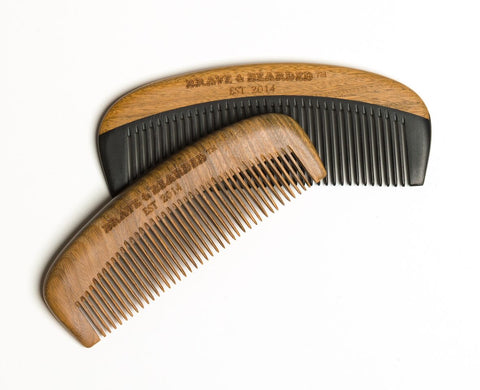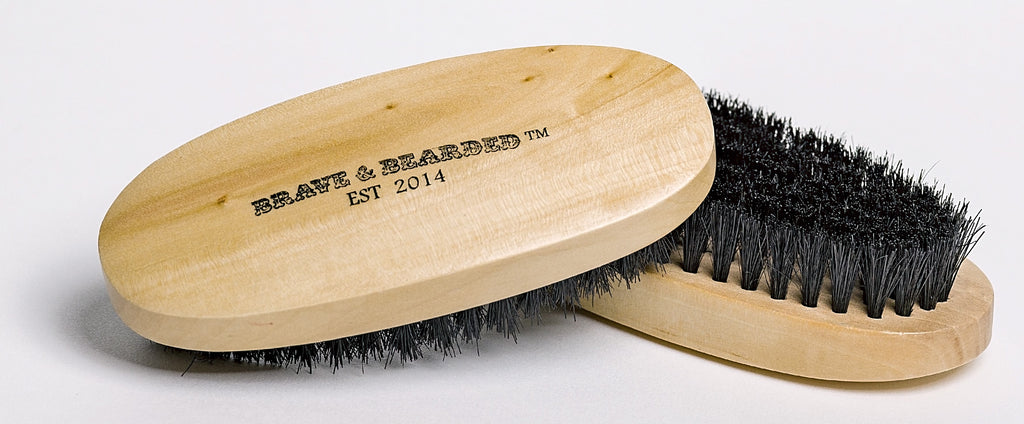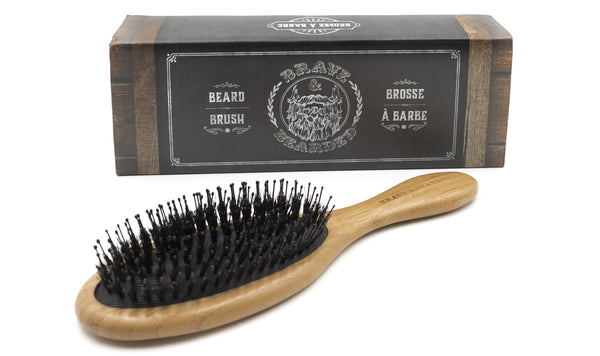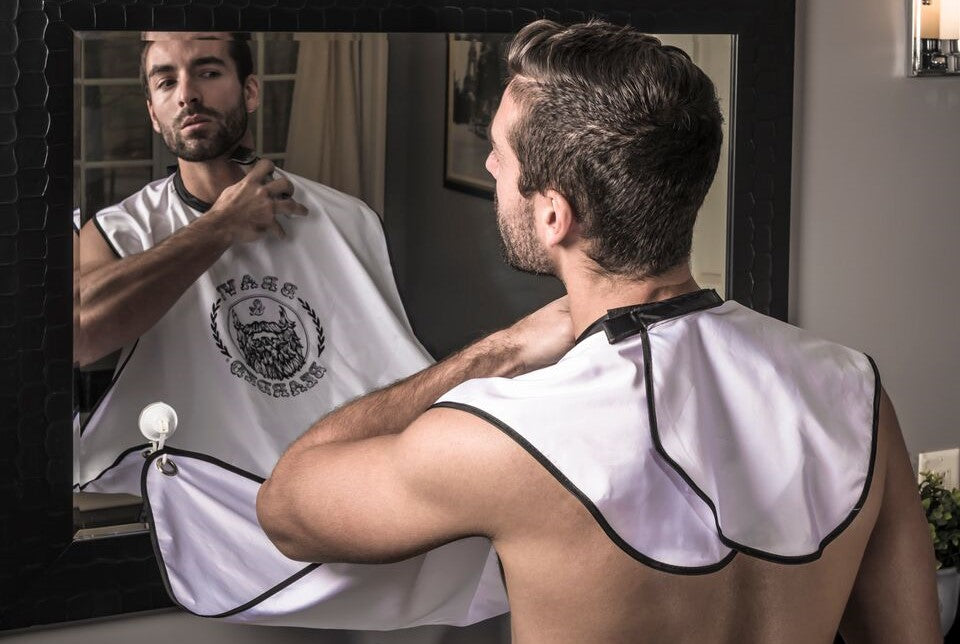How to Grow a Full Beard: The Ultimate Beard Growth Guide
How to grow a full beard: The Ultimate Beard Growth Guide
Charles Darwin, Leonardo da Vinci, and Abraham Lincoln all did it. Now, it’s your turn! It’s your turn to face trials and tribulations in your journey towards growing the best beard, designed for your unique features. Of course, no great success is accomplished alone. Just like it took these men above much help for their successes, you need as much help as possible to succeed in your beard growth journey. Let's start growing brothers!
This guide contains the information on all the beard growth stages, the tools you will need, the right beard fit for you, and everything to know on beard culture itself. So be excited!
You’re about to read the Ultimate Beard Growth Guide encompassing all the information we’ve learned through the years, and can be useful for a newbie or even a bearded expert. If you think there’s anything missing, don’t hesitate to reach out to support@bravenbearded.com to give us your input.
Time to get started! Start by choosing which beard style you like best from the ones below, then keep reading the guide to learn how to achieve your dream beard!
Part 1: Beard styles
A beard definitely changes your overall look and can be a great add-on to the style you're going for. However, not every beard style fits with every face shape, therefore it's important to understand for which beard you can go for, and how to maintain and groom it as well. Below, you'll find a collection of 27 of the most popular beard styles, and which facial shape they suit.
Short beard styles:
Clean Shaven
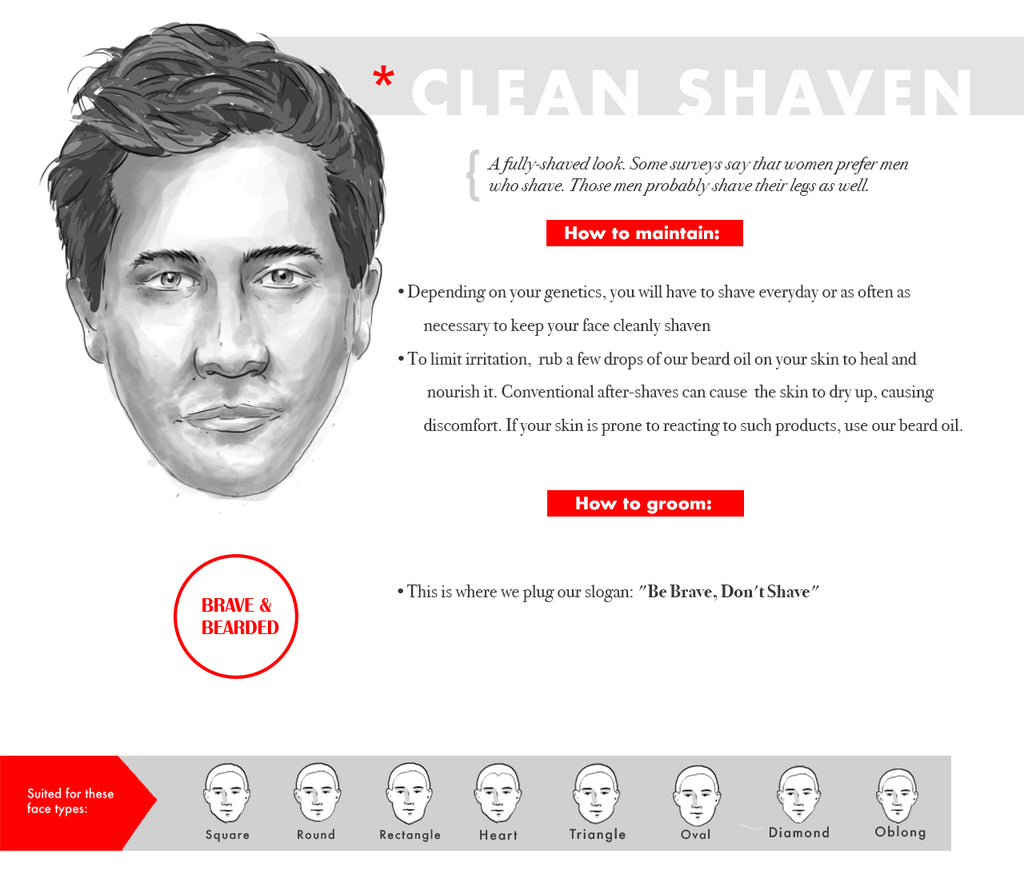
Soul Patch

Petite Goatee

Classic Goatee

Sideburns
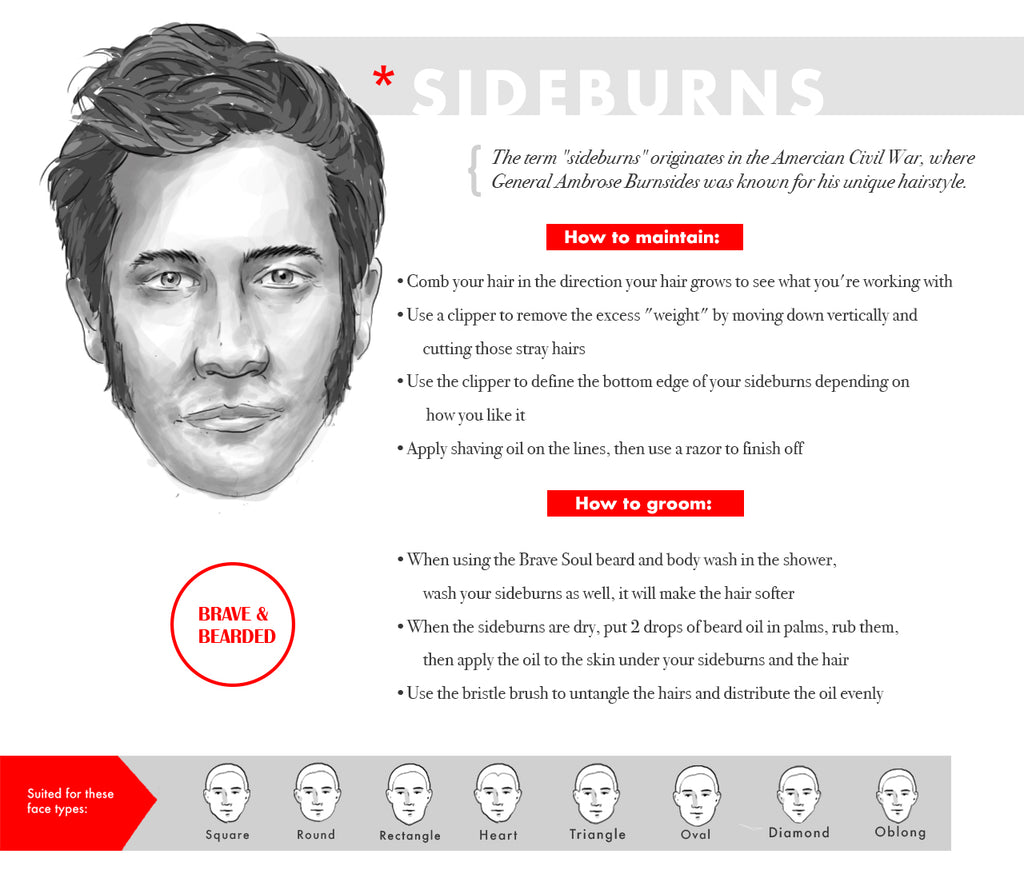
Wolverine

Chin strap

Chin curtain

Dutch
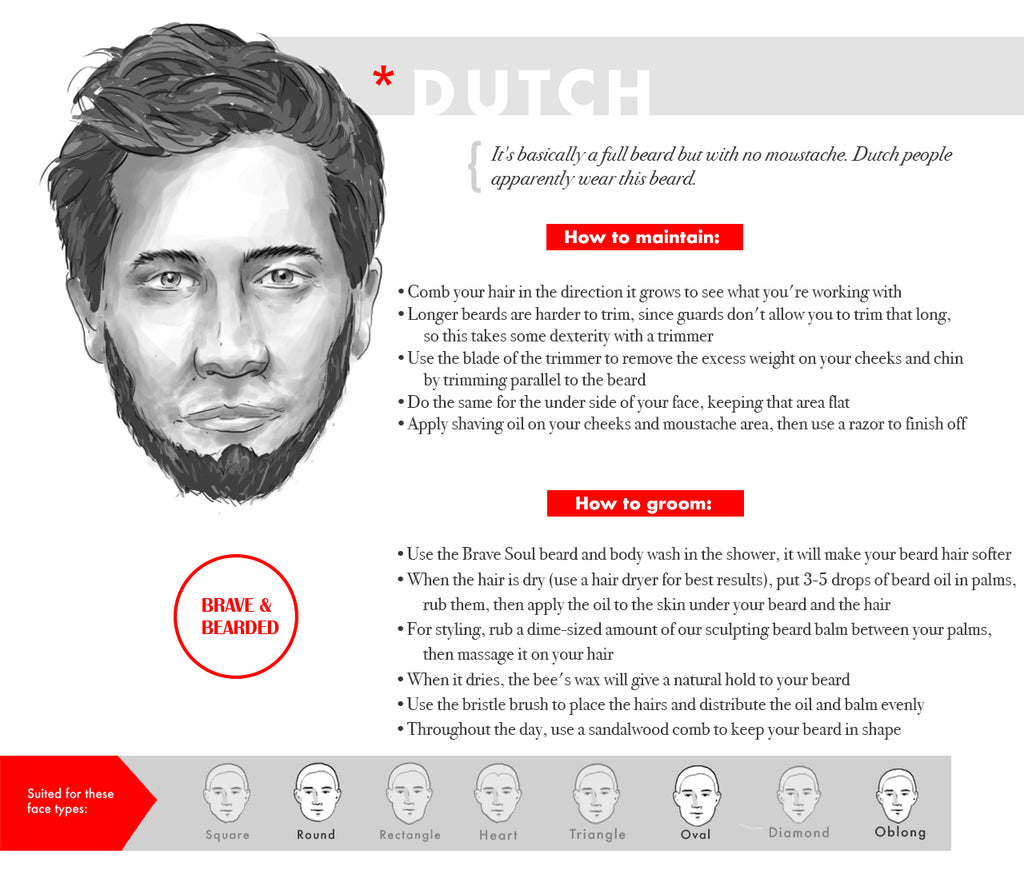
Balbo
Goatee & mustache

Van Dyke

Handlebar & chin puff

Winnfield
Short stubble
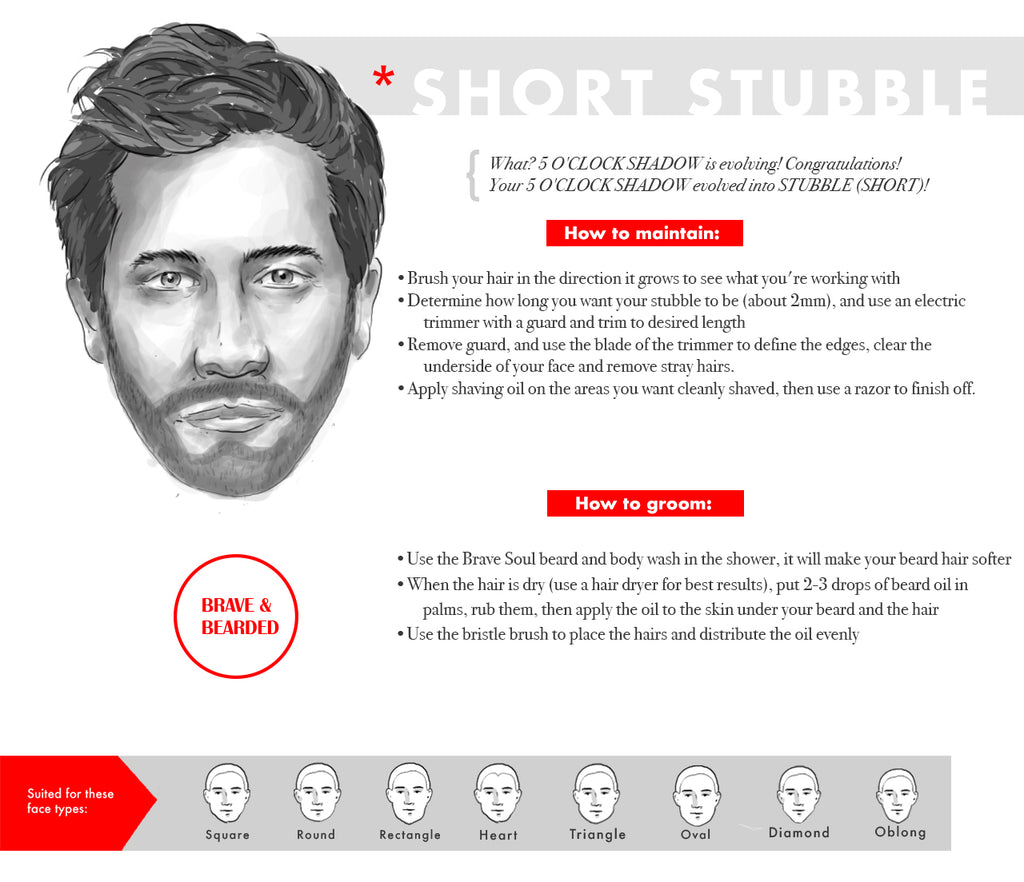
Medium stubble
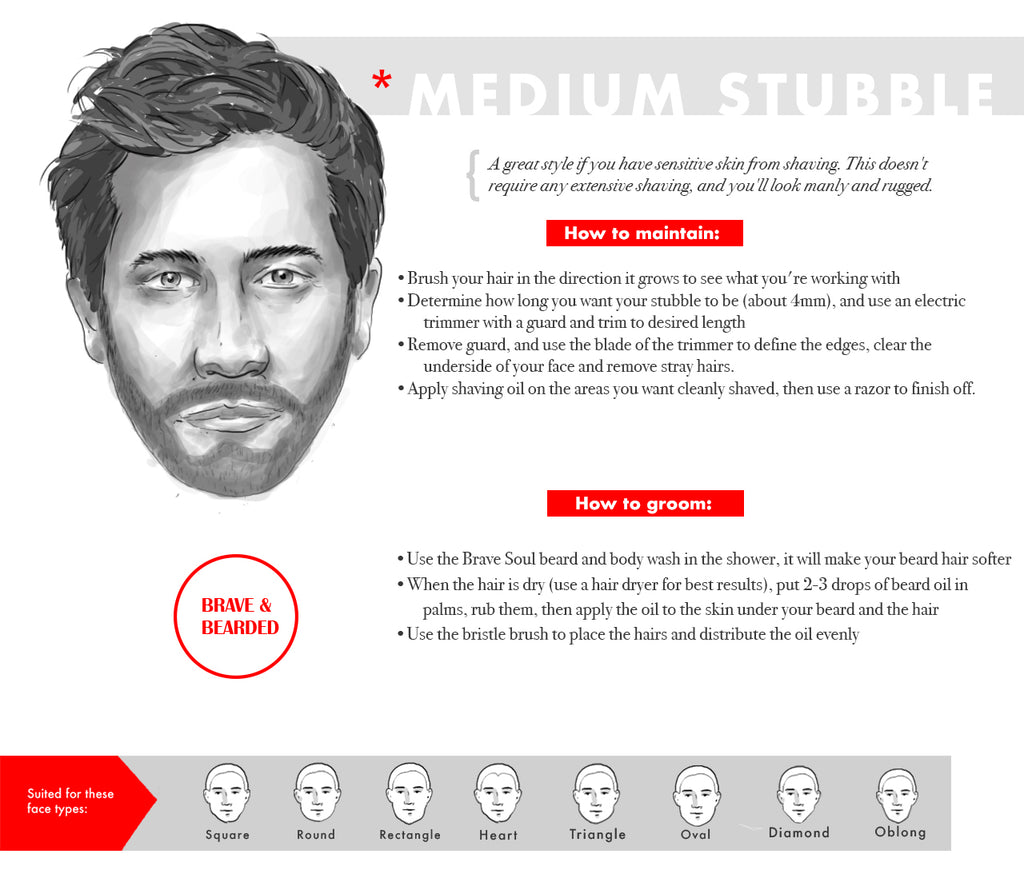
Long stubble
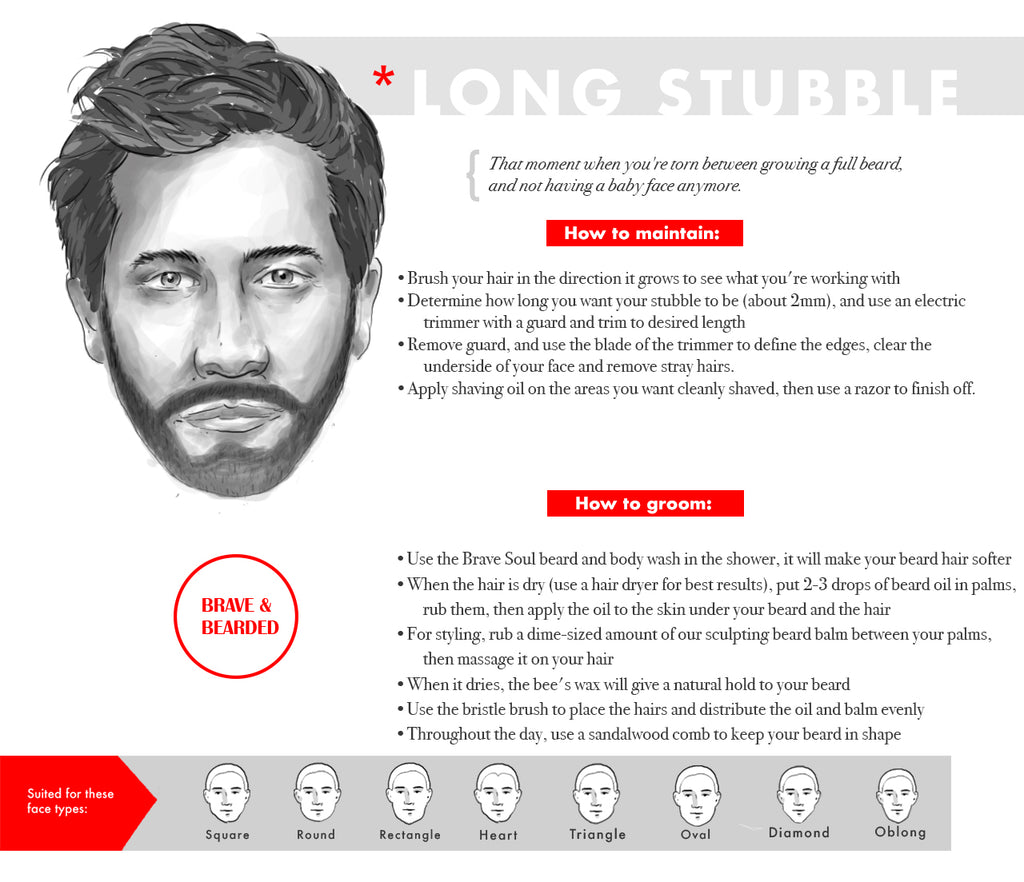
Medium beard styles:
Full beard

Short boxed beard

Corporate beard

Hollywoodian

Ducktail

French Fork
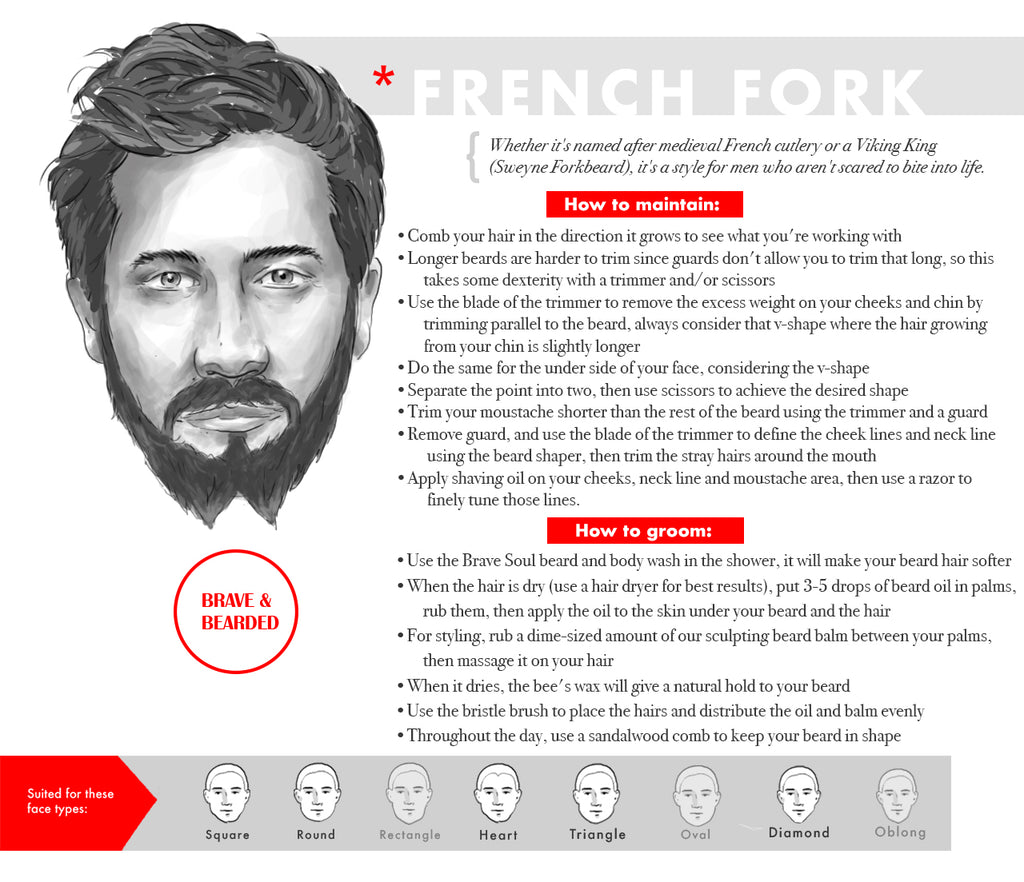
Long beard styles:
Old Dutch
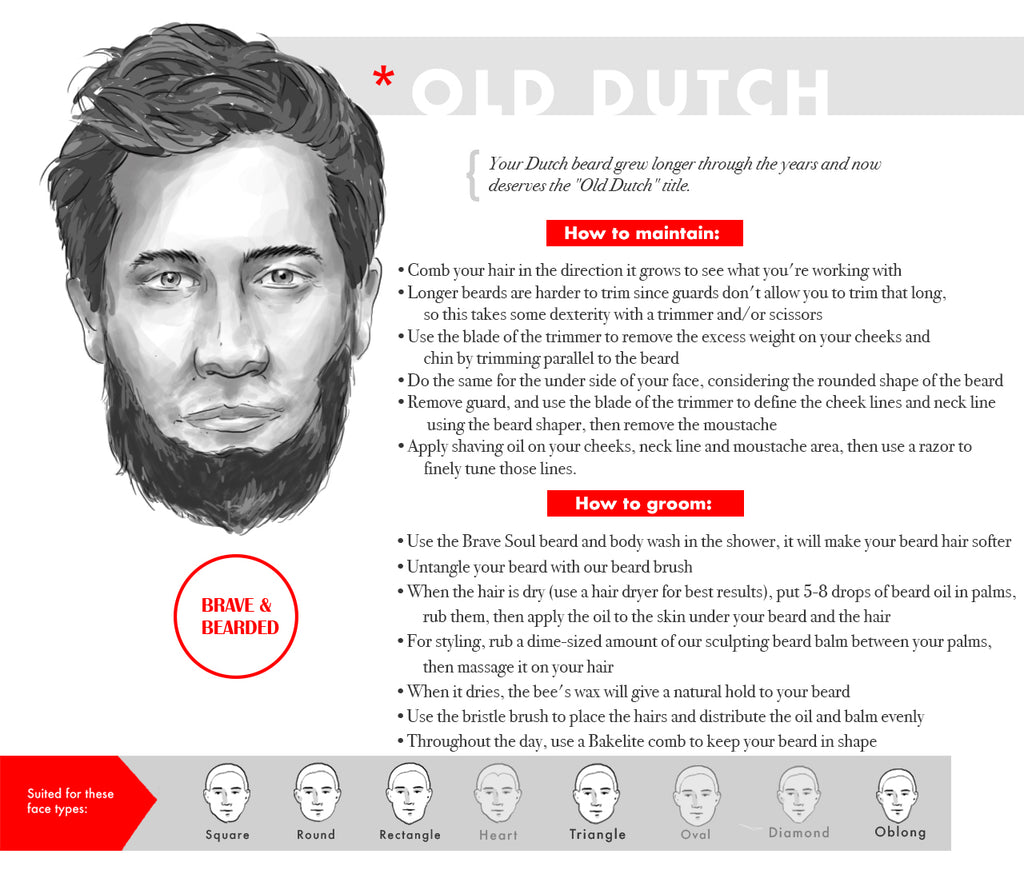
Garibaldi

Verdi
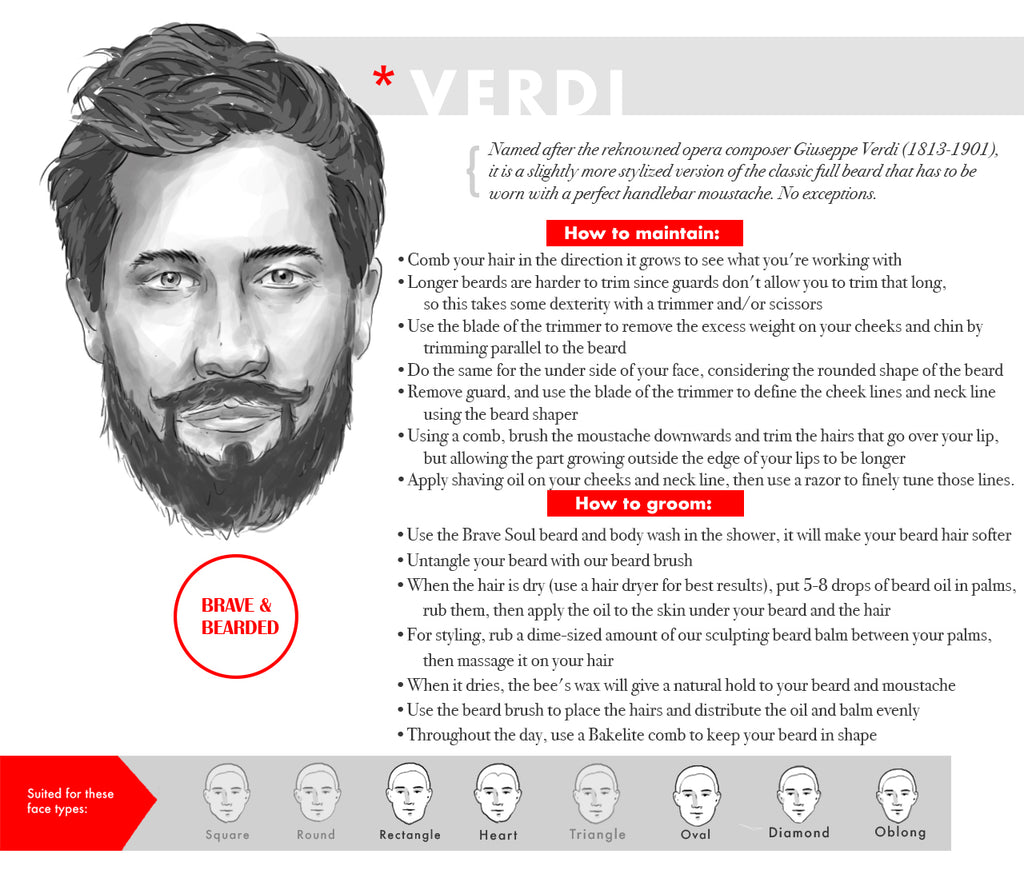
Yeard (Year-beard)
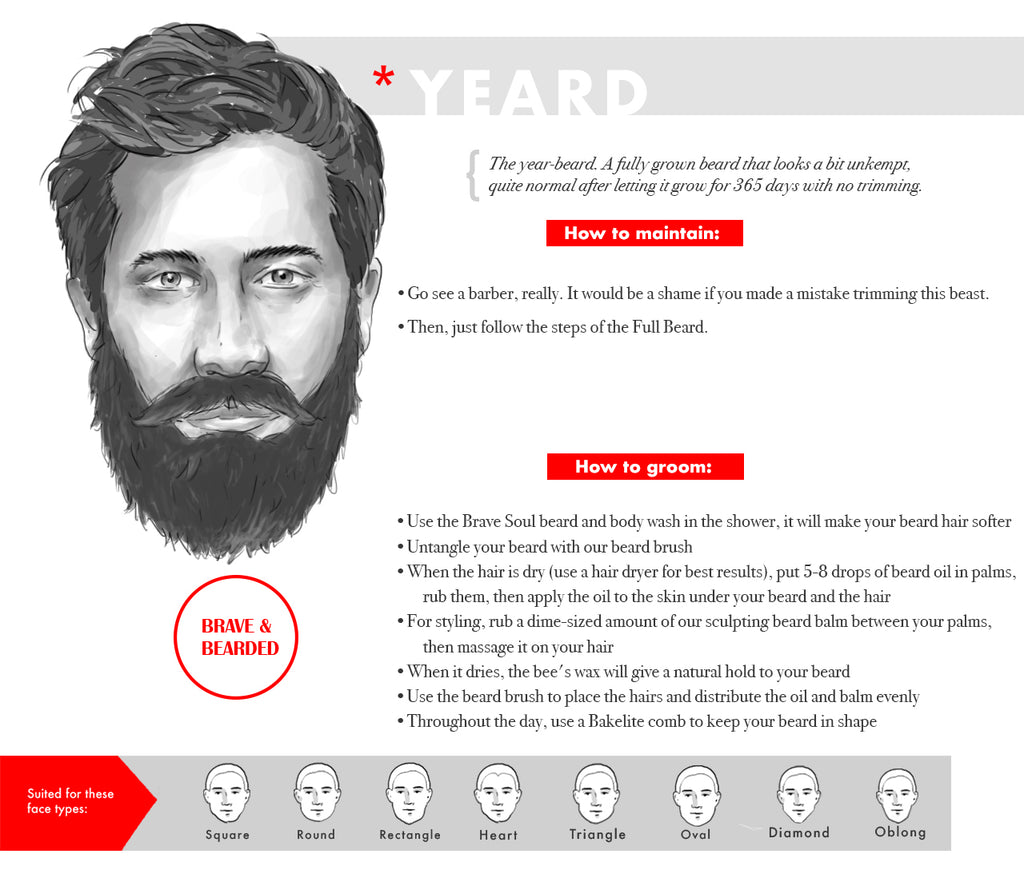
Part 2: The playbook for beard growth
Great news! Since you`ve already made it this far in the article, you already have the first and most important step of the beard growth process achieved: Commitment. Just as you would commit to losing "x" number of pounds as you join the gym, you must commit to growing "x" amount of time before shaving and quitting. No results can be achieved by skipping the process, and this first phase of growth requires patience.
Week 1 - The journey begins
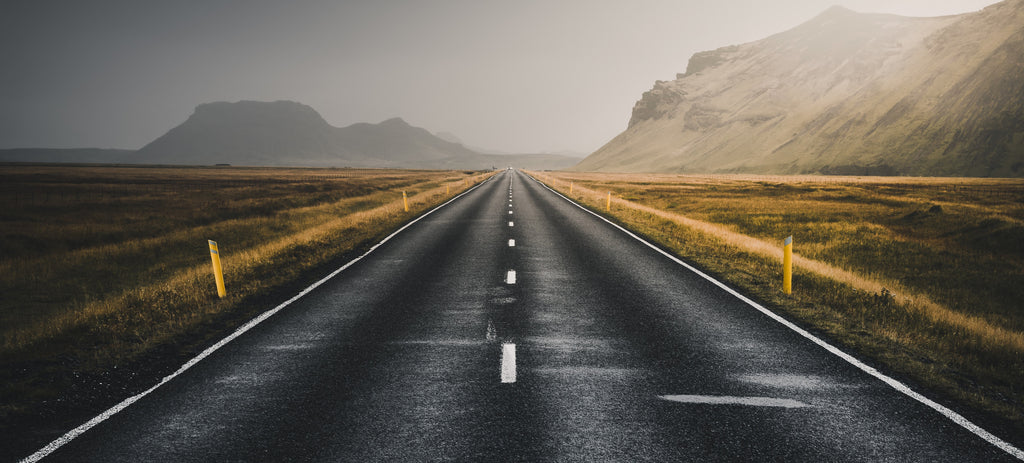
So, you have decided you're doing it, despite what others may think. You want to see yourself with a beard and you`ll do whatever it takes! Your first week is a patience game. Let your beard grow and don`t do any trimming. This step is building the foundation you need to get the beard you want in the future. It’s very easy to get excited and try to shape your hairs immediately into a look you think suits you best. Keep in mind that, if you’ve never grown a beard before, you're not even sure what a bigger styled beard looks like yet on your face, so don`t act on your trimming impulses yet. Because of the fact that you have been shaving before this, the hairs are sharp like spears and will curl up against your skin, creating itchiness. These early stages of growth will be the itchiest, so get your game face on!
It is essential to understand the relationship between your facial skin and beard. Properly maintained facial skin is the key to having a healthy and nourished beard. There are several ways you can take care of your facial skin. The best one, is hands down, beard oil. It is a composition of natural oils targeting the skin, to hydrate and nourish it. It softens the hairs for shaping, helps control irritations and skin conditions such as pimples, ingrown hairs and dead skin cells (a.k.a. Bearddruff). As if this weren`t enough, it helps the itchiness and usually has a great fragrance as well! This should be your first beard arsenal investment and is perfect for the early week 1 stage of growth.
Week 1 conclusion
Have patience, don`t touch your trimmer, no matter what! Make sure you apply your beard oil in the morning, after a shower while your pores and hair follicles are open for best absorption. Start taking pictures to document your beard growth stages. At this point, there shouldn`t be much to worry about socially and psychologically, as most of your peers have already seen you with stubble in the past. Don`t forget to pat yourself on the back for a successful first week! Now, let’s move on.
Week 2- Changes appear!

Alright, fellow growers, your beard is actually looking beardly! Your hairs are coming out, people are starting to notice your commitment and you haven`t touched the trimmer that is hidden away in a drawer somewhere. Perfect! Now, with the extra length of hairs, new devotees are embraced by the beard community to keep your beard looking shiny and healthy, instead of dusty and flaky. So, you’re using your beard oil, your skin and beard are feeling hydrated and nourished. What most people don`t know is that you might be the one causing the dryness in the first place! The skin on your face is the most sensitive of all skins on the body. Most shampoos and conditioners are designed for thick, tough scalp skin and have chemicals like parabens and sulfates which really dry up the facial skin but have little effect on the scalp. Using your regular shampoo for your new beard is a serious NO-NO. Your next task is to find an all-natural beard wash/shampoo to make sure you aren`t reversing the effects of that nice beard oil. Look for natural ingredients, chemical-free formulas with a neutral pH at 7 so there is no acidity drying up the skin. Avoiding shampoos with strong alcohols is recommended as well, as you can easily find some with vegetable-based alcohol that is gentler on the skin. This will help your new longer beard hairs not only to be softer but more malleable for shaping. Which brings us to our next tool for our week 2 beard.
A boar bristle beard brush is your new best friend. The bristles of the boar are rigid and soft at the same time, stimulating the skin’s surface to remove dead cells. Your beard at this stage is fuzzy and has unruly hairs tempting you to trim. Don’t do it! As mentioned above, you want to keep this foundation to work with later, so stay strong! This is why you need the boar bristle beard brush to place your hairs and train them for a groomed look. Socially, people are starting to comment on your beard. They are wondering if you’re going to keep it or if this is just a lazy phase. Talk to them about your new products to show your interest in the beard culture and in keeping a clean beard. Tell them this is a normal phase in the growing process, and that you have plans for grooming just around the corner.
Week 2 conclusion
Don`t be your own worst enemy! Stop drying out facial skin with regular scalp shampoos and get a natural beard wash. Get rid of dead skin cells and fuzzy hairs with a nice boar bristle beard brush which provides a groomed look. Tell everyone this is a natural stage of the growth process and that you need to let it grow before taking to the shaping aspect so they don`t think you’re just ‘being lazy’.
1 month - Your beard has arrived!
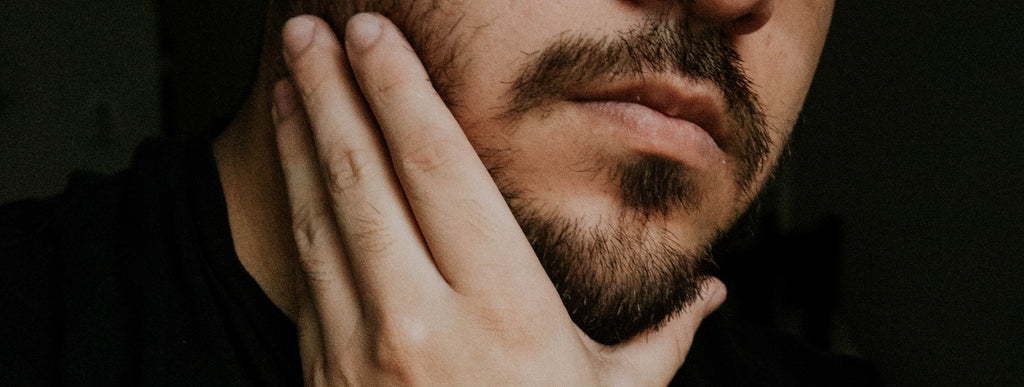
And just like that, you’re a beardsman! You don`t have a yeard yet (a one-year beard ) or a Z.Z. Top-status mane, but you are now for sure a bearded man in the community -- and trust me, it is a community! People have started to comment constantly on it, giving their opinions and sharing their bearded experience. So now, it`s time to shape-up! Yes, you have been patient and you can`t even remember where your trimmer is anymore. You have succeeded and it’s about to get very interesting. Now you have a nice, filled-in amount of beard hair. At this point, it’s all over the place and without any style, but it’s ready!
Cheek lines and necklines are your new focus. This can be achieved in different ways. Let us start by assuming you’re doing it on your own. In general, your natural cheek lines are what you are going to want to follow. Get rid of the stray hairs above the line and try using tools to do it evenly on both sides. A beard shaper is made for this. It is a beard tool with 2 different angles you can follow to have perfectly even cheek lines, and that’s not all, it does the neckline as well. Typically, you’ll want to follow the bottom of your ears, trimming all the hairs that are where the neck meets the head. Your necklines on both sides should meet just above your Adam’s apple. If you aren`t confident enough to attempt this after all the effort you put into growing it, that’s understandable. Go to an experienced beard barber and have him do it the first time. A good barber can definitely give you some pointers on how to groom yourself and shape your beard so you can maintain it afterward with the trimmer and scissors. When trimming the ends of your hairs, use a comb to pull the hairs up so the length is even, and use scissors to cut the hairs in a straight line. Always remove less than you think you should the first time, so you don`t accidentally cut too much.
Now that you are starting to trim regularly for grooming, there are several new tools you'll need for your beard arsenal. A beard bib is a bib that attaches directly to the mirror in front of you while being wrapped around your neck creating a canopy for all the hairs trimmed to fall into. You can avoid hairs in the sink, therefore avoiding issues with roommates or partners! Another great new tool for your beard grooming is shaving oil. Yes, you read correctly, an oil for shaving! Many people use an opaque foam with chemical ingredients to stop irritations while shaving their linings. An oil has the advantage of being transparent, so you can see what you are doing. It is also made with natural oils, hydrates and reduces the irritation on your skin so it doesn’t feel worse after you do your lines. For your moustache, use scissors to keep an even trim without cutting too many hairs at a time. Cut a straight line parallel to the top lip to avoid eating your new moustache. Similarly, to trimming your beard use a comb to lift the hairs up on the moustache, so you can cut an even line across its length.
Shaping & Training
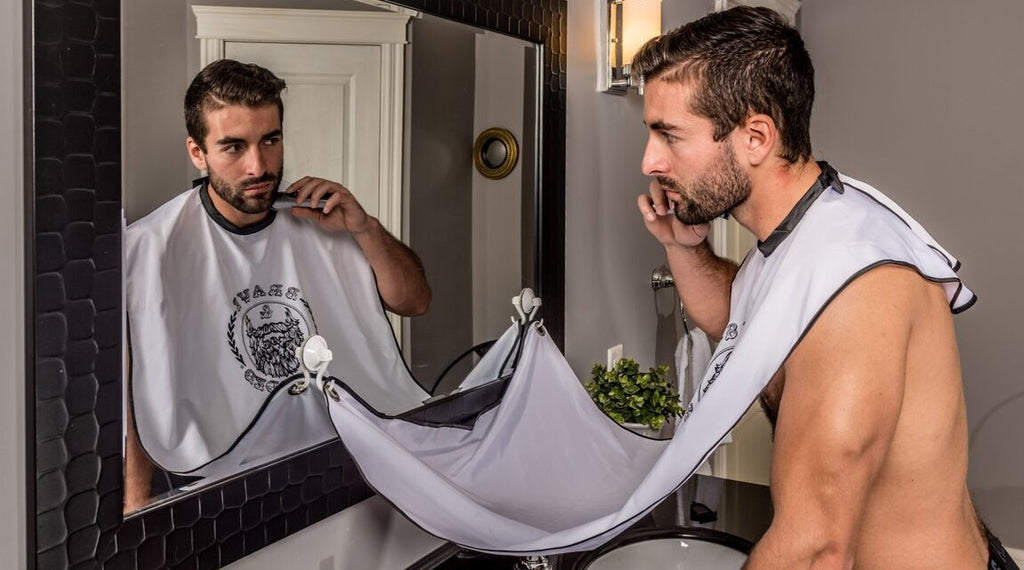
Your beard is now fairly imposing after a month without any shaving or trimming. You might even surprise yourself with how different you look! Manliness and testosterone pump through you as you show off your new beard. However, an unkempt beard won’t get you the right attention. Now that you’ve taken steps towards trimming and shaping your beard, there are techniques towards keeping the shape of wavy, rebellious hairs. This is what you want to do: You want to find yourself a good sculpting beard balm. This will be your new best friend. Find a high-quality formula containing natural oils, beeswax and shea butter which is one of the best hydrators out there. A balm softens up the beard even more than the oil, adds a layer of protectiveness against environmental wears and allows a medium hold so you can place your beard and have it stay that way for the day (similar to a pomade for hair). Add it into your routine right after applying the beard oil for the best effect. There are several beard oils and balms made with the same fragrance, so you don`t have to worry about clashing scents.
Next up, one of the most underrated tools you may already have: the blow dryer. As soon as you step out of the shower, it is recommended to use the blow dryer to remove all the water creating pressure on the hair follicles and causing dandruff. Not only this but if you place your beard while blow drying it, you will train the hairs in the direction you place them. Keep the blow dryer at a minimum distance of 15 cm from the hairs to avoid hair damage. Ideally, you’ll do this and follow-up with the oil and balm afterward, holding the shape you gave your beard in place. Lastly, you may have noticed by now your moustache is curling into your mouth! Don`t worry, moustache wax was made for this. A good mustache wax is made with white beeswax, which has a strong hold, allowing you to shape it and keep those hairs out of your nose and mouth!
1-month conclusion
Wow! That was a lot of information, but now you have the basics in proper beard maintenance that apply to every stage of beard growth. In short: Start trimming those cheek and necklines, even if you need a barber to show you how at first. Beard shapers, shaving oils, and beard bibs are all very useful beard arsenal tools now. Help keep your new shape and make it look clean and professional with a sculpting beard balm, a blow-dryer, and moustache wax.
Of course, there are longer stages down the line in beard growth, but these are the essential first steps. Following these tips will give you the tools and knowledge to do whatever suits you best with your beard from here onwards. Which brings us to part 3!
Part 3: Your Beard Products & Grooming Accessories

Here is a list of what you need, and the information to get the suitable products. Let’s get right into it!
Beard oil
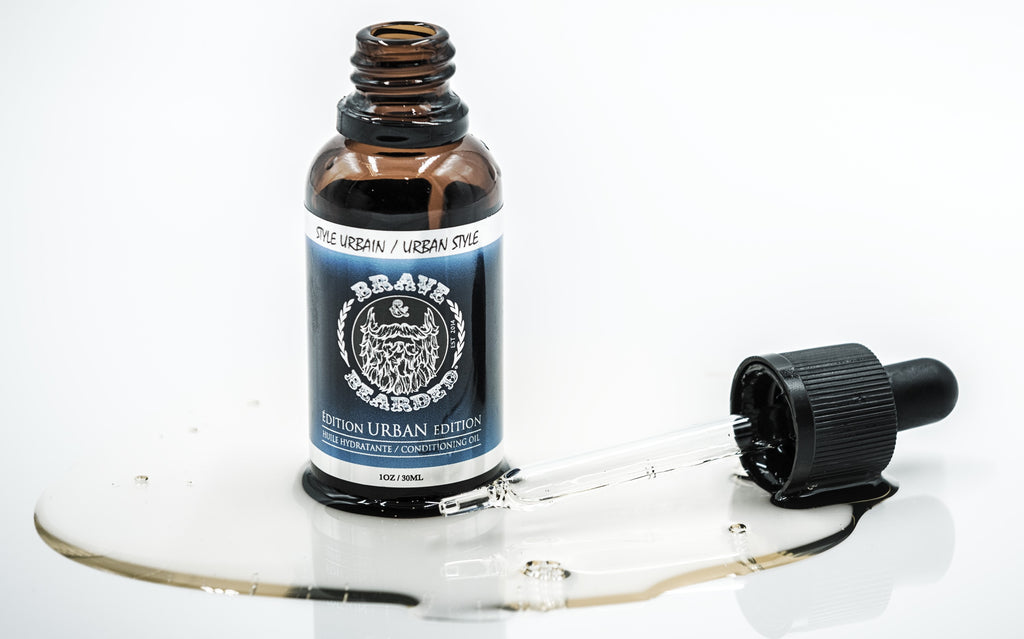
Beard oil is the bread and butter of beard products. It is made from a blend of different and varying amounts of natural oils that have many benefits for skin care, hydration, nourishment and softening of hairs. There are many different oils that can be used in the formulas. Some include almond oil, grapeseed oil, castor oil, coconut oil, jojoba oil, pure vitamin E and many more. If you have a white beard, try staying away from argan oil as it tends to give a slight yellowish tint to beards. Jojoba oil is a high-quality beard oil that you should look for in your beard oil. It has many properties, including but not limited to: effective relief from eczema and psoriasis, antibacterial properties that help control bacterial growth in the hair follicles, anti-inflammatory and, when used regularly, jojoba can control acne problems. These are just a couple of tips on beard oils, so make sure you choose yours wisely!
For a small beard, 2-3 drops are recommended. Medium beards will be in the 4-7 range. And large beards will be 8 and up. Finding a good beard oil with a dropper can be extremely useful for gauging the quantities you use. Rub the oil between your hands and apply it on your face and beard.
Shaving oil
Alright so we all know the foam-like substance we’ve used on our face to shave with. Not a bad product if you’re shaving your entire face, but less optimal if you have to see what you’re doing for linings. Plus, why not use a shaving oil when it’s actually better for your skin, at the same time? A shaving oil has the advantage of being transparent so you can actually see what you’re shaving. Hard to be that precise with the foam. Plus, it’s made with natural oils so you’ll not only be getting a smooth shave without cuts, but you’ll also have hydrated and nourished skin afterward.
Sculpting Beard Balm
There are many beard balms out there, such as hydrating balms and beard butters. Since those two are mainly hydrating, let’s focus on the sculpting beard balm, which has the added advantage of being a shaper as well. Made with natural oils, sculpting balms will almost always have beeswax in them. A yellow bee's wax typically has a medium-strength hold which lets you place your hairs like a pomade would for your hair. Try finding one formulated with shea butter, as this helps for a good hold and is one of the best hydrating ingredients out there. To use a sculpting balm, "scoop" some out with the nail sides of your thumb, since it can be hard in texture. Then place it all in the palm of your hand, rubbing them together to create heat, which will melt the balm. Lastly, once the product is well blended, without any bits left, apply on your facial skin and beard hairs.
Moustache Wax
This is the way to tame that moustache which constantly threatens to creep into your mouth and nose. Made with natural oils and white beeswax, the hold is a strong one. You’ll get a stronger hold from a moustache wax than a balm, allowing you to go as far as twist the ends of your mustache, if that interests you.
Beard shampoo/wash
This is a big one. As mentioned before, regular hair shampoos can really dry up your facial skin. If it ’s made with natural ingredients, it’s even better for your delicate facial skin. There are many shampoos out on the market right now, so make sure to look for one without acidity, which dries up the skin. Also, a vegetable-based alcohol would be ideal, or any non-damaging alcohol. There are also many 3-in-1 natural beard shampoos out there, meaning you can wash your body and hair at the same time, with the same product, saving you cash.
Blow dryer

Ideal for removing water from the hair follicles, eliminating dandruff. Also amazing for training the hairs to go in the direction you comb/brush them. Make sure to always keep a minimum distance of 15 cm away from the hairs to avoid damaging them.
Trimmer

Another essential tool to have in your arsenal. Perfect for getting rid of those stray hairs, and when used jointly with the beard shaper, you can achieve perfect cheek and necklines for your beard.
Beard Shaper
This is a must-have for do-it-yourself at home trimming and shaving. It is a boomerang-shaped tool that has two angles from which to choose from for cheek lines and necklines. This will ensure symmetry on both sides of the face, leaving even lines and a fresh look.
Beard combs
There are many different beard combs, for many different situations! A wooden beard comb is typically a beardsman’s best friend. Wood is a good material to pick for your comb because it absorbs the products in your beard, reapplying them later on as you comb throughout the day. Combs are very handy as they are extremely portable and good for shaping your beard on the go! If you don`t like the idea of a wooden comb or don`t like your products absorbing in the wood, try Bakelite combs.
Bakelite is a polymer which is more durable than plastic, it’s anti-heat (good for blow drying), anti-static and resistant against chemicals. This ensures your products won’t absorb in it, and it’s also very easy to wash. The ideal comb for salons.
Beard Brushes
There is one bristle that rules them all in the beard world, and that is the boar bristle. With its exfoliating properties and massage-like feeling, this boar bristle brush even goes as far as increasing blood flow to the beard follicles, stimulating hair growth. Great to use with a sculpting balm and to train the hairs into place when shaping.
For those with long beards which a regular boar bristle brush no longer penetrates, there’s something out there for you as well. A big beard brush exists, made with longer synthetic bristles and boar bristles at the lower level of the brush. This brush reaches in deep for long hair or beards and has exfoliating properties at the same time! This brush untangles in one to two strokes every time, even when the hairs are wet.
Beard Bib
Also commonly referred to as the marriage savior, a beard bib is a practical tool used to avoid big messes and clogging your sink with hairs. Made with a nice soft material, the bib wraps around your neck and attaches to the mirror in front of you, performing like a canopy catching all the hairs as you trim. This great tool will help shave off time in your maintenance routine.
Part 4: What IS a beard?

After reading the title, you may be thinking "I know what a beard is! I've had one for 2 years!", but how well do we actually know the process that gives us our manly manes? The basic anatomy of beards is similar for all men. The follicles on your facial skin are the small holes from which all your beard hairs grow. And there are thousands of them! The health of the follicles and the number of them is pretty much based on genetics.
Your beard hairs consist of 3 parts which are the cuticle, the cortex, and the medulla. The medulla is the most inner core of your hair structure. The curliness or straightness of your hairs comes from the cortex, the middle layer of your hair, which can be round or oval. The color of your hairs is determined by the melanin which is in the cortex. The final and outer layer of your beard hair is known as the cuticle, which helps filter out water so that the cortex doesn't absorb too much of it. Lastly, there is the root inside of the cuticle which is oval in shape and where the hairs grow from.
Cycles of growth

Your beard hairs have cycles of growth which consist of 3 parts:
- Anagen Cycle: Lasting 2 to 6 years, this beard hair cycle of growth is the longest and most common. Currently, about 80-90% of your beard hairs are in this cycle and it is in this cycle that the hairs grow.
- Catagen Cycle: Lasting about 3 weeks only, about 2% of your hairs is currently in this cycle. Basically, your hair follicles become smaller as the production of melanin stops.
- Telogen Cycle: Also known as the "shedding cycle", this phase currently involves about 10-15% of your beard hairs. After the catagen cycle, the telogen cycle takes place and the old hairs fall out. Shortly after, the hairs will grow again as the anagen cycle starts again in that same follicle.
So there you have it! These are the cycles your beard hairs go through, and now you know why you keep seeing hairs fall out sometimes. Don't worry, it’s normal as long as the growth process starts out again. A bad diet and high-stress levels are the leading cause of prolonged telogen cycles, so make sure you’re doing your best to be all around healthy!
Things you can do to optimize beard growth

A healthy diet is an important aspect of your hair growth, and of your life in general. After all, you are what you eat! There are certain supplements that can help your beard hair growth and these are: multi-vitamins, biotin, fish oil, zinc, vitamin B and magnesium. Increasing your testosterone can also help. Try eating red meats, avoiding soy products, prioritizing sleep, and minimizing stress. Other great foods to include in your healthy diet are spinach, nuts, avocados, olives, broccoli, and olive oil. Lastly, don`t forget to keep moving and exercise as frequently as possible (this makes your body go into recovery mode, which can help a lot with beard growth). Your body will thank you!
Basically, your beard and its qualities are mainly genetic, but just like the rest of your body, there are many actions you can take to help it stay healthy. Now that you know, you can take those steps to ensure you have the healthiest beard on the block!
Part 5: Ingredients and their properties
You’re now using beard products all the time and you love what they do for you. So, what exactly are the components of these products, and what are they doing to your facial skin and hairs? This comprehensive list will ensure you understand what’s going on your face, and what the effects are.
Jojoba Oil
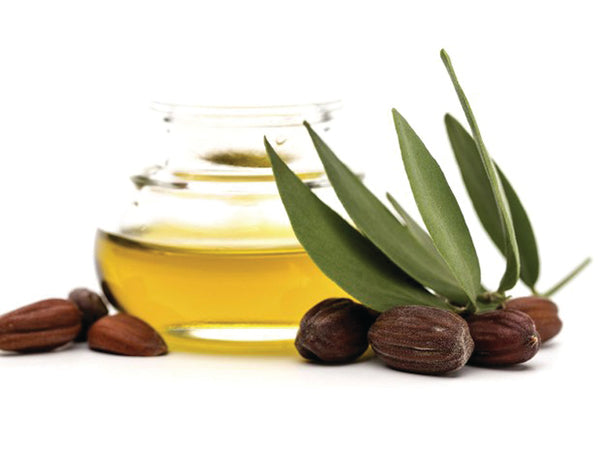
Jojoba oil is an amazing one, folks! It’s the liquid that comes from the jojoba plant, mainly found in southern California, southern Arizona, and northwestern Mexico. About half of the weight of the seed is the oil. Jojoba has great shelf-life and is high temperature resistant. Native Americans used the oil historically to treat their wounds. Machine guns were even lubed and maintained with jojoba oil during the second world war! Here are some of the benefits it has on the skin and hair:
|
1) Skin Moisturizer |
|
| 2) Helps against razor burn |
|
|
3) Helps the overall health of your skin |
|
| 4) Keeps hairs healthy |
|
| 5) Includes vitamin E |
|
| 6) Includes vitamin B complex |
|
| 7) Helps treat fungi and infections |
|
Castor Oil
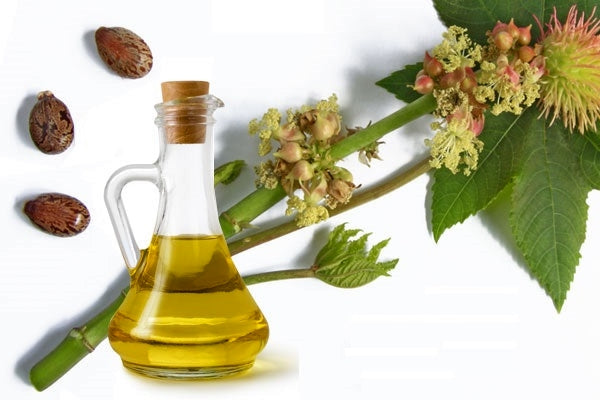
Castor oil has a long history of use for humanity and comes from the castor plant. It has been discovered that ancient Egyptians used castor oil as a natural skin care serum and as a treatment for eye irritations. Ayurvedic medicine, commonly practiced in India, uses castor oil for bacterial prevention and skin-healing. Here are some of the benefits it has on the skin and hair:
| 1) Helps diminish skin Inflammation |
|
| 2) Helps with signs of aging |
|
| 3) Helps reduce pimples |
|
| 4) Skin moisturizer |
|
| 5) Fades blemishes |
|
| 6) Promotes hair growth |
|
| 7) Treats scalp infections |
|
| 8) Delays hairs from going grey |
|
| 9) Conditions and hydrates hairs |
|
Almond oil
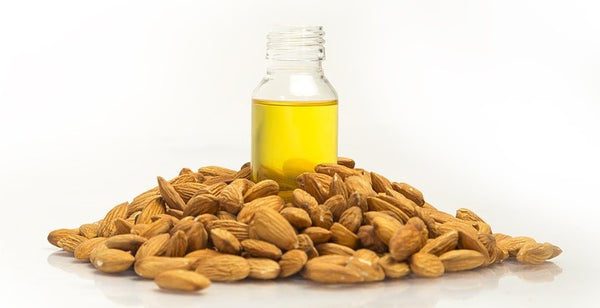
The almond tree was first domesticated in Southeast Asia and in the Mediterranean. There are two variations of the oil that comes from almonds: sweet and bitter. The bitter one can be somewhat poisonous after processing, however sweet almond oil is used worldwide for its skin and hair care properties. Here are some of its benefits on the skin and hair:
| 1) Keeps skin hydrated, smooth and clean |
|
| 2) Treats psoriasis and eczema |
|
| 3) Helps against skin rashes |
|
| 4) Helps delay fine lines and signs of aging |
|
| 5) Relieves muscle pains and fatigue |
|
| 6) Helps diminish hair loss |
|
| 7) Helps protect hairs |
|
Coconut oil
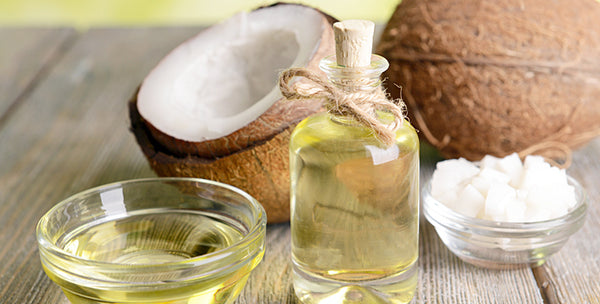
Coconut oil is 99% fat, of which 82% of are saturated. Just 100 grams of this oil contains 890 calories! The Philippines and other tropical countries used this oil as a fuel for transport vehicles and even use it to power generators! Even India used coconut oil as the primary source for lighting before switching to electrical power. Here are some of its benefits for the skin and hair:
| 1) It’s a great moisturizer |
|
| 2) It’s an excellent cleanser |
|
| 3) It’s an antibacterial shield |
|
| 4) Has antifungal properties |
|
| 5) Protection against U.V. rays |
|
| 6) Minimizes wrinkles and premature aging |
|
Grapeseed oil
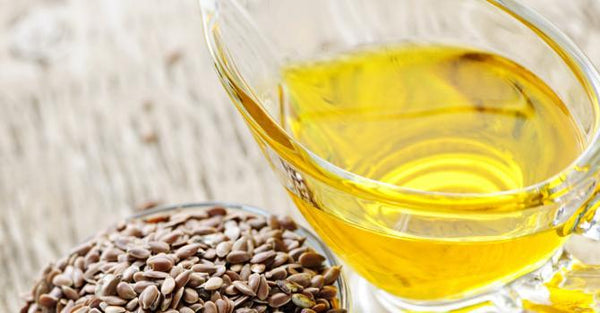
Grapeseed oil benefits go way back and can even be found in medical writings describing health benefits by ancient Greek philosophers. Medical practitioners of old Europe used the oil to create ointments to heal skin and eye irritations. The leaves of the grape plant were also used to stop blood flow from wounds and to treat inflammation. Here are some of its benefits on the skin and hair:
| 1) Helps many skin conditions |
|
| 2) Cleans the skin |
|
| 3) Maintains healthy hair |
|
| 4) Has medicinal properties |
|
Vitamin E
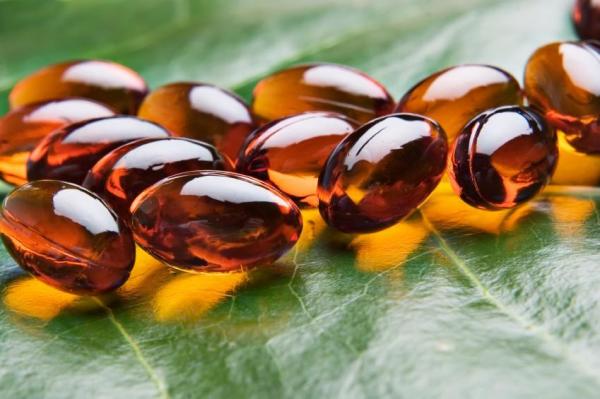
Vitamin E was first discovered in the early 1900s by Hebert Evans and Katharine Bishop and first isolated in its pure form shortly afterward. In 1938, Widenbauer used vitamin E on 17 premature babies who had growth failures. Eleven out of 17 resumed regular weight gain! Here are some of the benefits it has on the skin and hair:
| 1) Restores Moisture |
|
| 2) Reverses sign of premature aging |
|
| 3) Contains powerful antioxidants |
|
| 4) Cleans the skin |
|
| 5) Promotes hair growth |
|
| 6) Conditions hair |
|
Shea Butter
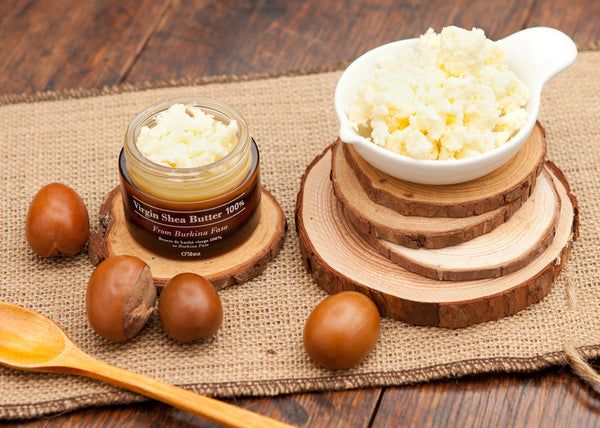
Shea butter is harvested from shea nuts from the versatile Shea tree. This butter has been used for thousands of years by the people of Africa in harsh desert-like climates. The nuts would be crushed and boiled into a butter, to be used to protect skin and hair from environmental damage, the drying sun and even to treat insect bites. Shea butter has even been traced to the first century at the time of Queen Cleopatra of Egypt. Stories were recorded of the Queen demanding large jars of the shea butter to anoint her skin with for hydrating and rejuvenating effects. Here are some of its benefits to the skin and hair:
| 1) Amazing moisturizer |
|
| 2) Treats several common skin conditions |
|
| 3) Helps for Shaving |
|
| 4) Helps with eczema and dermatitis |
|
| 5) Helps treat damaged hair |
|
Beeswax
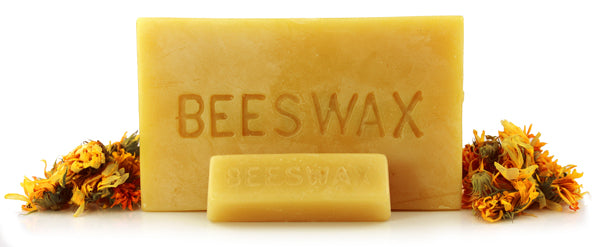
Beeswax is the main product of the beehive. Honeybees build their combs from beeswax and secrete the wax from eight glands on their abdomens. It has been found that in the 18th-19th centuries, women who had skin marks from smallpox would use beeswax as a treatment. It’s even suggested that the term " Mind your own beeswax!" came from that time. Also, the first evidence of a dental filling was found in a 6500-year-old man from the Neolithic times, and guess what it was made with? Beeswax! This was likely used to help relieve pain and sensitivity. Here are some of its benefits to the skin and hair:
| 1) It's a powerful skin booster |
|
| 2) It’s a great moisturizer |
|
| 3) Minimizes sensitivity and irritation |
|
| 4) Has many benefits for your hairs |
|
On top of these amazing ingredients, there are 3 plants we use in our shampoo that also have powerful benefits:
Burdock Root
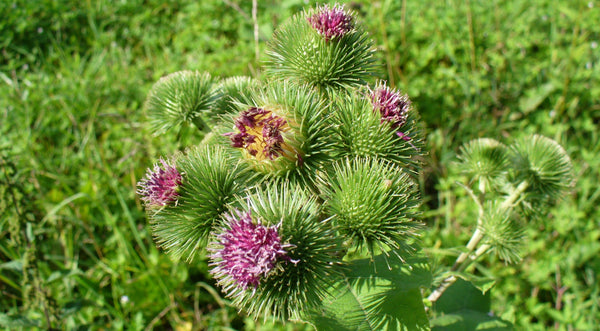
Burdock plants are large plants with characteristic small seeds that latch onto anything they touch. George de Mestral from Switzerland used this concept after looking at these seeds under a microscope to create what is now known as Velcro. Here are some of its benefits to skin and hair:
| 1) Treatment for skin conditions |
|
| 2) Natural antibacterial and antifungal properties |
|
| 3) Helps promote healthy hair |
|
Nettle
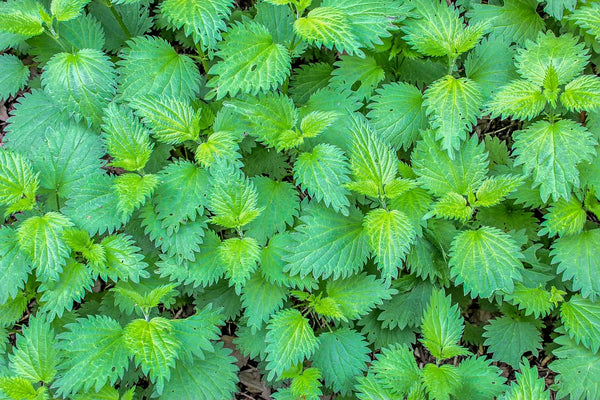
Nettle is also called stinging nettle for its prickly features that sting on touch. Centuries ago, Europeans had to resort to eating this prickly plant in the spring, when food supplies were low. This amazing plant has even been used as a tonic to produce more milk for lactating mothers. However, nettle really has amazing properties when it comes to your scalp and hair!
| 1) Promotes hair growth |
|
| 2) Helps create healthier hair follicles and hair shafts |
|
| 3) Helps control excess oiliness |
|
| 4) Minimizes dandruff and flaky scalp |
|
| 5) Helps treat itchiness, irritations, and sensitivity on the scalp |
|
Rosemary
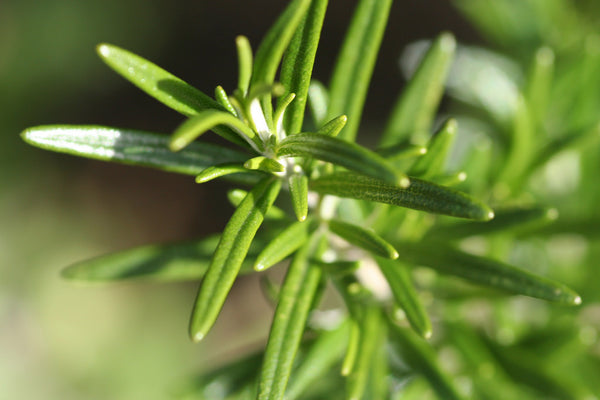
The word Rosmarinus is Latin for rosemary and translates literally into "mist of the sea". This is probably because it grows so well on the coast of the Mediterranean Sea, where just the humidity from the sea is enough to hydrate this plant effectively. Did you know there is an organization known as the International Herb Association? Well, it exists, and rosemary was chosen by the association to be "Herb of the Year" in 2000. Here are some of its benefits to the skin and hair:
| 1) Helps fight Dandruff (and beardruff too!) |
|
| 2) Helps boost skin circulation |
|
| 3) Helps rejuvenate hairs |
|
| 4) Helps with skin conditions |
|
| 5) Keeps skin looking healthy |
|
Most common beard issues
Ingrown hairs
Ingrown hairs are a common occurrence which happens to most bearded men. They are due to a beard hair not being able to exit the follicle because of dirt or dead skin cells clogging up the pore, causing it to curl around and grow back into your skin. This causes inflammation of the follicle and can be very itchy. This is more frequent amongst men who have very curly or thick beards. The best way to treat these is by exfoliating with a boar bristle brush, to remove all the dead skin cells which are lodged in your beard. Secondly, using a proper beard shampoo to cleanse the skin to remove all the dirt that could be in your beard. Afterward, using our beard oil will also help a lot to treat the ingrown hairs, either caused by shaving or by natural occurrence, due to the cocktail of natural oils contained in the recipe, specifically chosen for their benefits to the skin and hair. It will take a few days before the ingrown hairs disappear but doing these things will greatly help.
Beard Dandruff
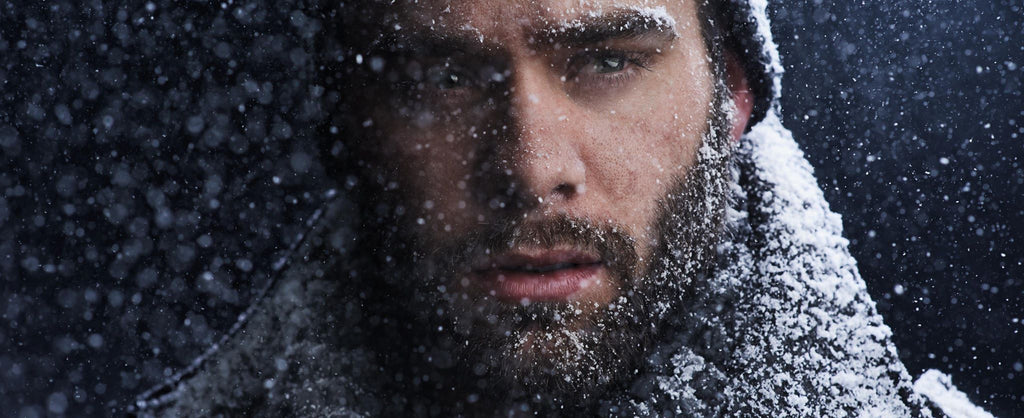
Beardruff, as it is often called, can be caused by many things. It can be caused by dry skin, which can be fixed with proper exfoliation and skin hydration, or by too much sebum on your skin, which is fixed by properly cleaning your beard with a sulfate-free shampoo. Another cause is leaving your beard damp after the shower. Using a hair dryer on a medium setting (don’t get too close to your hair) will help in taming your beard as well as removing all the water.
Split-ends
These are inevitable, every bearded man will have split ends, which occur naturally. However, some people might have more split ends than others, since they do not keep their beard well-hydrated with the use of high-quality beard oils. The hairs start splitting when the hairs get too dry. Using shampoos containing sulfate will damage your hair as well since sulfate is a type of salt. Another cause of split-ends is by drying your beard with a towel. You should only pat dry, and not rub your beard, that will damage the hairs. Using a bad pair of scissors can also lead to split-ends. Make sure you use a good pair of beard scissors that have a high hardness rating (at least 55+) and that are very sharp. Blunt scissors can rip out hairs, and will not effectively cut, leading to butchered tips, which will then split. Finally, another cause which is harder to address is tugging at your beard. Most guys do this when they’re thinking, or simply do it unconsciously. This can also be very damaging, it would be best to stop this bad habit.
Itchiness

This is one of the biggest reasons why many men don’t let their beard grow out. Around the 2-week mark, where the hairs still touch the face, that’s when it is at its worse. For all other lengths, itchiness is often caused by dry skin, ingrown hairs, etc. The best remedy for itchiness is doing the Brave routine, discussed in the FAQ. Keep your beard hydrated and free of dead skin cells, that’s the trick.
Zits
Zits are usually caused by an accumulation of toxins and bacteria in your beard, or by pores clogged by sebum. The best way to get rid of zits is by washing your beard frequently with a sulfate free shampoo, and daily use of beard oil. Our oil contains ingredients like jojoba and castor oil, that are good at dealing with bacteria on the skin. They also do not contain ingredients like silicone, which can clog pores and exacerbate the acne.
Smelly beard
A beard will become smelly when not washed often enough. Touching your beard with unclean hands will add bacteria and dirt in your beard, which can cause it to smell. Also, not properly drying your beard (longer beards) after a shower can give it an unpleasant humid smell.
Eating
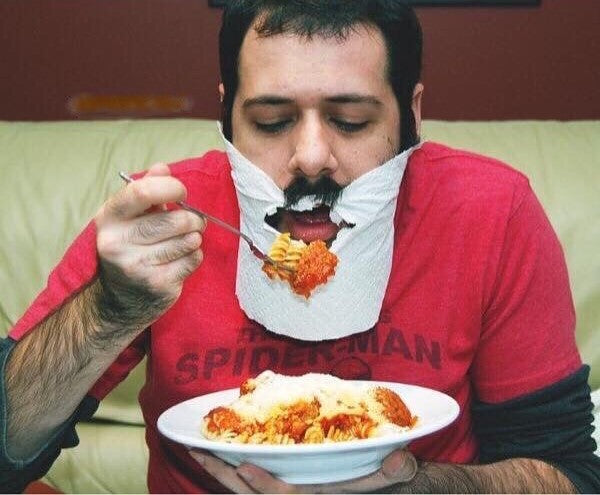
Who knew they’d have to relearn how to eat when they have a long beard? It’s a reality! This is more the case with long beards with a long moustache. The issue comes from the fact that your beard and moustache might be obstructing your mouth, so food can definitely come in contact with the hair. The best things you can do is use moustache wax to move your ‘stache out of the way, and beard balm to keep your beard from sticking out too much. You might want to hold your beard as you’re about to take a bite into something, to prevent crumbs from falling into it. Other than that, you’re on your own, you’ll have to find your own tricks to be able to feed yourself.
Frequently Asked Questions In The Beard World
1) Does Shaving Make Your Beard Grow?

No. This is a common misconception and is not supported by science anywhere. In fact, several experiments were conducted in the attempt to see if shaving versus not shaving made a difference in the growth process of your hairs. Both studies, one held in 1928 and one held more recently, concluded that there is no difference is the hairs growth process when you shave it or not. One dermatologist said " If hair grew back stronger every time you shaved or waxed it, women would have gorilla legs already since they shave or wax them frequently". We also wrote an article that goes more in depth on this subject, which you can read here.
2) How Big Should My Beard Be to Use Beard Care Products?
This is a very common question and the answer will surprise you. You don't need a beard to benefit from using beard oils. "Beard oil" is an exceptional product to help maintain and nourish the beard, however, half of the oil’s benefits relate directly to the skin. This means, hypothetically, everyone could be applying beard oil every morning or night to help keep their skin hydrated and nourished. People suffering from skin conditions like eczema or psoriasis will benefit immensely from using good oils on their skin frequently. Beard oils are quickly replacing after-shaves, because they provide the same effect, if not better, and they contain only natural ingredients.
3) Can I Use Beard Balm and Beard Oil Together?
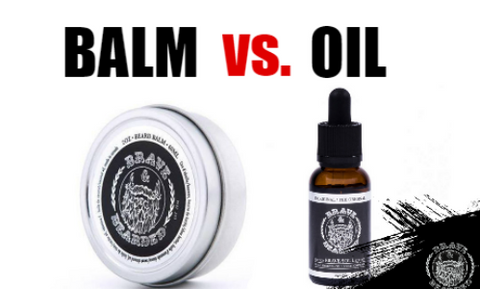
Yes. Beard balm and beard oil have different properties so using them together is very beneficial. The oil is a great moisturizer, which deeply nourishes the skin and keeping it in overall great health. The oil helps soften it while helping many skin conditions like ingrown hairs, acne, and pimples. The beard balm, on the other hand, also has hydrating properties. Using both oil and balm boosts the moisture level of your skin, by sealing it in.
4) What is the best routine to take care of my beard?
We call it the BRAVE routine. It goes as follows:
- Five minutes before the shower, use the boar bristle beard brush to remove all the dead skin cells lodged in your beard, which will allow you to clean your beard in depth with the beard wash.
- Trim all stray hairs or split ends before the shower (it’s best to do this when your beard is dry)
- Wash your beard with the beard wash and leave the lather in your beard for the entirety of your shower.
- Five minutes after your shower, and your beard is almost dry (pat dry with a towel or use a hair dry), apply a few drops of beard oil in your hand, rub them together, then reach the skin under your beard (proper beard care starts with skin care), and apply the remainder on the outside of your beard.
- Rub a dime-size amount of beard balm between your palms until it melts, then apply it to your beard. When it dries, it will give more volume to your beard and allow you to shape it.
- Finish it off with a good brushing to redistribute the oils across your whole beard.
The Ultimate Beard Growth Guide Conclusion
We would like to thank you for taking the time to read our Ultimate Beard Growth Guide, in the hopes that this information will help you grow an amazing beard in no-time! If you ever find yourself facing an issue that isn't described in this guide, make sure you write to us directly either on our Facebook page or directly through the Contact Us page on our website. We want to reiterate that this guide contains the information that we've accumulated through the years, and we might have overlooked certain concepts. If that is the case, please write to us at support@bravenbearded.com and share what you think should be contained in these pages, in order to make this guide as informative as possible.
Stay Brave!
